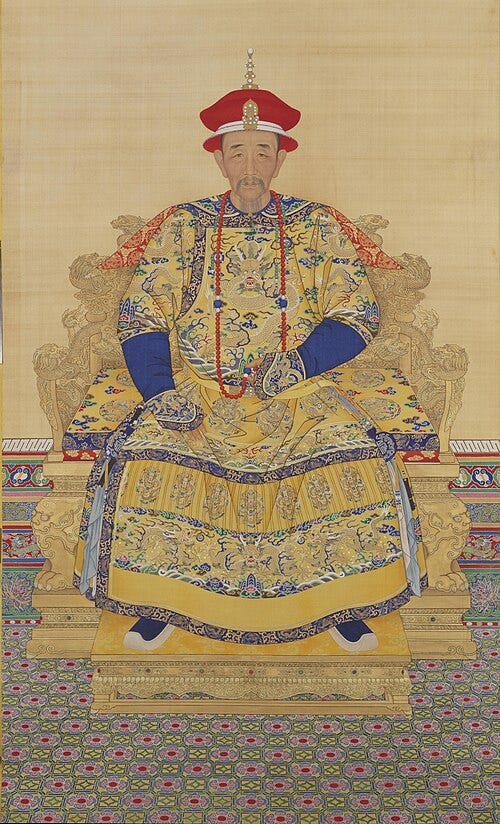How Modern China began in Qing Institutions
Part One of a Deep Dive into Klaus Mühlhahn, Making China Modern
Welcome to the first instalment of my eight-week deep dive into Klaus Mühlhahn, Making China Modern: From the Great Qing to Xi Jinping. This deep dive series complements the China leg of my World History tour by reading one leading scholarly history of modern China.
The first instalment looks at how modern China began in the social, political, and cultural institutions of the Qing dynasty during the period 1644 to 1800.
How Modern China Began in 1644
Many popular histories of how China became modern look back to the Century of Humiliation, provoked by the Opium wars and the subjection of China’s weak, internally focussed civilization to the dynamic energy of foreign powers. This story frames China as an historical actor out for revenge. Humiliation drove the Revolution. Now it drives China to overturn Western hegemony. The resentful laggard wants to get revenge for what the West did to its imperial ancestors.
Mühlhahn, Making China Modern: From the Great Qing to Xi Jinping takes a different approach. He winds the story of modern China back to the start of the Qing dynasty in 1644, and its Age of Glory between 1644 and 1800. Of course, influences, ideas and institutions stretch back even further; but 1644 - four years before the Treaty of Westphalia - is a significant turning point for this history tour of world powers.
The great powers were in equilibrium across Eurasia in this period. As John Darwin argued in After Tamerlane, the Western world did not achieve a decisive advantage over the Rest until the Eurasian Revolutions of geopolitics (e.g. conquest of India), economics (e.g. Industrial Revolution) and culture (e.g. civilizational supremacy) that occurred between 1750 and 1830. Indeed, in 1751, Mühlhahn wrote:
“The Great Qing had attained enormous size and was perhaps the most powerful Eurasian empire of its time. (p. 21)
Its power rested on many foundations.
Demographic growth, expanded communication networks, rapid commercialization, and new forms of critical thinking had enriched social and intellectual life in the seventeenth century. (p. 21)
It projected this power across the world, and had not, despite popular historical myths, closed its mind to exchange with the outside world.
The empire was also not closed to the outside world. On the contrary, it stood at the center of economic networks and flows that incorporated it into the larger South China Sea economy and, beyond that, into the global economy. Seen from a global perspective, the Qing age of glory and splendour contributed to the formation of the early modern world, in which it came to occupy a central place as the most advanced region.” (pp. 21-22)
This Qing age of glory and splendour was a triumph of a diverse East Asian world order. It was conditioned by both top-down and bottom-up factors.
Two Emperors of the Early Qing
The top-down factors included the stable, capable leadership of two remarkably long-lived rulers, the Kangxi and Qianlong Emperors.
Kangxi (r. 1661–1722)
The Kangxi Emperor, born Xuanye in 1654, ascended the throne at the age of seven, becoming the fourth emperor of the Qing dynasty. His 61-year reign marked one of China’s most prosperous and stable periods, consolidating Qing rule after the turbulent Ming-Qing transition. Kangxi assumed personal control in 1669, overthrowing the regent Oboi, and demonstrated exceptional leadership in military, cultural, and administrative affairs.
A skilled military strategist, Kangxi suppressed the Revolt of the Three Feudatories (1673–1681), annexed Taiwan (1683), and countered Mongol and Russian threats, securing China’s frontiers through the Treaty of Nerchinsk (1689). Domestically, he promoted Confucian governance, commissioned the Kangxi Dictionary, and patronized arts and sciences, including Jesuit scholars who introduced Western astronomy and cartography.
Kangxi’s economic policies, such as tax reforms and flood control projects, revitalized agriculture, while his tours of the south strengthened ties with Han elites. Despite later succession disputes, his reign laid the foundation for the High Qing Age of Glory.
Qianlong (r 1735 to 1795)
The Qianlong Emperor, born Hongli in 1711, ruled China for six decades (1735–1796). Grandson of the Kangxi Emperor, Qianlong expanded the empire through military campaigns and diplomacy. His Ten Great Campaigns (1755–1792) subdued the Dzungar Mongols, and asserted dominance over Tibet and Nepal, though expeditions against Burma and Vietnam proved less successful.

A patron of the arts and scholarship, Qianlong amassed an unparalleled cultural legacy. He commissioned the Siku Quanshu (Complete Library of the Four Treasuries), the largest literary compilation in Chinese history. He sponsored porcelain, painting, and jade crafts. There was both literary flowering and persecution.
Domestically, he promoted prosperity but struggled with corruption. Population growth strained resources. By his abdication in 1796 (to avoid surpassing Kangxi’s reign length), rebellions like the White Lotus uprising signalled decline. The dynasty’s 19th-century crises were beginning.
Qing Institutions that Made China Modern
Both weaknesses and strengths grew from the bottom-up during the age of glory of the Qing. This bottom-up layering formed the foundation of modern China. We will see, in next week’s deep dive, how the crises of the nineteenth century stressed the institutions of Chinese society to the absolute limit, especially since human-induced climate change broke into modern history.
But first let’s dive deeper into how Klaus Mühlhahn, Making China Modern: From the Great Qing to Xi Jinping reinterprets the story of the Qing.





